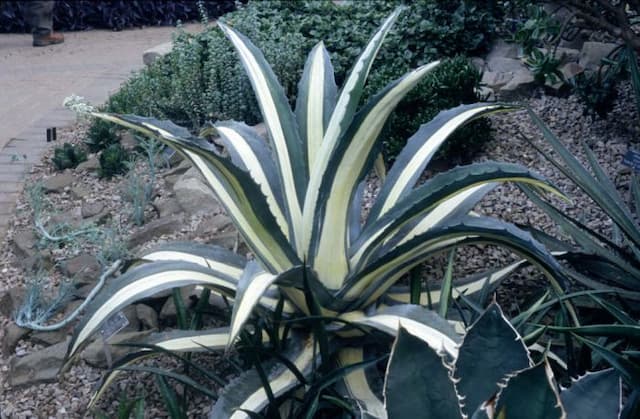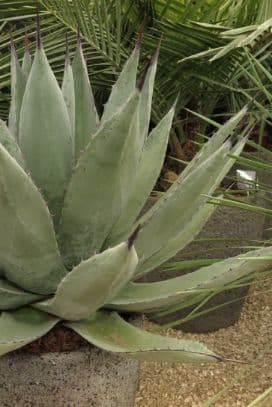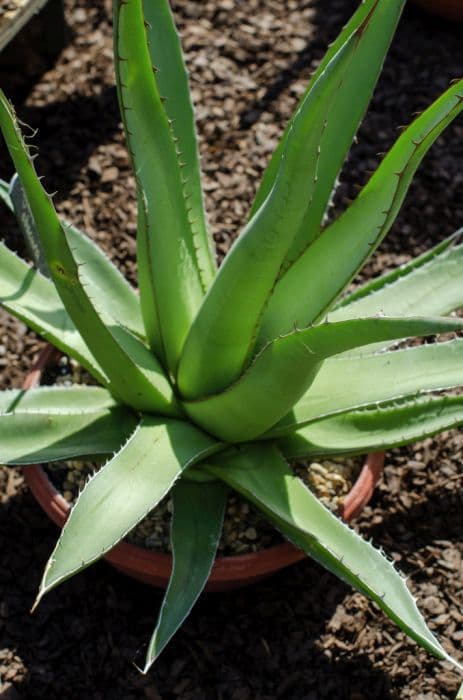Miniature Hosta Hosta 'Frosted Mouse Ears' (PBR)

ABOUT
Hosta 'Frosted Mouse Ears' is a charming cultivar notable for its distinctive foliage. The leaves are characteristically heart-shaped with a thick, lush texture. The name 'Frosted Mouse Ears' alludes to the small, rounded leaves that somewhat resemble the silhouette of a mouse's ear. The leaves exhibit a variegated pattern; the centers are a deep green while the edges are broadly and irregularly margined with creamy white to soft yellow, creating a contrast that enhances the "frosted" effect. Over time, the plant develops into a dense mound, with the leaves overlapping to create a full appearance. The plant produces delicate flowers on slender stems that rise above the foliage. The blooms are typically bell-shaped and can range in color, often adding a subtle but attractive touch to the plant. It's a favorite among gardeners who appreciate ornamental foliage and use it in shaded garden landscapes, border fronts, or as an accent in container plantings.
About this plant
 Names
NamesFamily
Hostaceae
Synonyms
Plantain Lily, Funkia
Common names
Hosta 'Frosted Mouse Ears'.
 Characteristics
CharacteristicsLife cycle
Perennials
Foliage type
Deciduous
Color of leaves
Variegated
Flower color
Lavender
Height
1 foot (0.3 meters)
Spread
1 foot (0.3 meters)
Plant type
Herb
Hardiness zones
3
Native area
Asia
Benefits
 General Benefits
General Benefits- Attractive Foliage: Hosta 'Frosted Mouse Ears' has distinctive variegated foliage that adds visual interest to a garden.
- Shade Tolerance: This hosta can thrive in shaded areas where other plants might struggle, making it ideal for woodland gardens or shaded borders.
- Low Maintenance: Requires minimal care beyond the occasional watering and removal of dead leaves, making it great for busy gardeners.
- Drought Resistance: Once established, it can tolerate periods of drought better than many other garden plants.
- Garden Design Versatility: Suitable for a variety of garden designs, including borders, containers, and ground cover.
- Pest Resistance: Resistant to many pests, reducing the need for chemical treatments.
- Seasonal Interest: Offers visual interest throughout the growing season with leaves and flowers, with foliage texture and color persisting from spring to fall.
- Cold Hardy: Can survive in colder climates and tolerate frosts, which makes it a robust choice for northern gardens.
 Medical Properties
Medical PropertiesThis plant is not used for medical purposes.
 Air-purifying Qualities
Air-purifying QualitiesThis plant is not specifically known for air purifying qualities.
 Other Uses
Other Uses- A unique addition to container gardening: Hosta 'Frosted Mouse Ears' can be used to create interesting contrasts with other plants in a container arrangement due to its distinctive foliage.
- Miniature gardens: Its small size makes it an ideal plant for fairy gardens or other miniature garden settings.
- Ground cover in shaded areas: Hosta 'Frosted Mouse Ears' can be planted en masse to create an attractive and low maintenance ground cover in shaded gardens.
- Ornamental edging: This Hosta can be used along paths or garden borders to define spaces with its charming foliage.
- Photography subject: The unique appearance of the leaves can be quite photogenic, making it a great subject for garden photography enthusiasts.
- Accent plant in rock gardens: This plant can add textural and color contrast in a rock garden setting.
- Collector's item: Due to its PBR (Plant Breeders' Rights) status, Hosta 'Frosted Mouse Ears' may be sought after by plant collectors as a valuable addition to their collection.
- Juxtaposition with bold foliage plants: Planting it alongside plants with larger leaves can create an intriguing visual effect in the landscape.
- Leaf casting: The distinct leaves of Hosta 'Frosted Mouse Ears' can be used to create concrete leaf molds or casts for decoration or as a unique garden stepping stone.
- Seasonal garden transitions: This Hosta's foliage is interesting from spring until frost, making it a great addition for gardens that require plants with long visual interest.
Interesting Facts
 Feng Shui
Feng ShuiThe Hosta plant is not used in Feng Shui practice.
 Zodiac Sign Compitability
Zodiac Sign CompitabilityThe Hosta plant is not used in astrology practice.
 Plant Symbolism
Plant Symbolism- Resilience: The hosta can thrive in a variety of conditions, signifying the ability to adapt and persevere through challenges.
- Devotion: Being a perennial that returns each year, the hosta represents loyalty and long-lasting relationships.
- Friendship: With its lush foliage and non-intrusive nature, the hosta is often shared among friends, symbolizing camaraderie and trust.
- Peace: The calming green of the hosta leaves is associated with tranquility and a peaceful state of mind.
 Water
WaterThe Hosta 'Frosted Mouse Ears' prefers consistently moist soil, but be careful not to overwater as this can lead to root rot. Water it deeply once a week, providing about one gallon of water to ensure moisture reaches deep into the soil. During hotter, drier periods, you may need to water twice a week, while in cooler or rainy conditions you can water less frequently. Reduce watering in the fall as the plant prepares for dormancy. Always check the top inch of soil for dryness before watering to avoid over-saturation.
 Light
LightHostas, including the Hosta 'Frosted Mouse Ears', thrive in partial to full shade. They do best in filtered sunlight, avoiding the harsh afternoon sun which can scorch their leaves. An ideal spot would be under the canopy of trees providing dappled sunlight, or on the north or east side of buildings where they can receive morning light and shade in the afternoon.
 Temperature
TemperatureThe Hosta 'Frosted Mouse Ears' is hardy and can tolerate a range of temperatures but thrives best in temperatures between 50°F and 75°F. They can survive minimum temperatures down to about -30°F, but growth will be stunted in heat above 85°F. Ensure the plant is protected from extreme heat by providing sufficient shade and moisture.
 Pruning
PruningPruning the Hosta 'Frosted Mouse Ears' is mainly done to remove dead or damaged foliage and to maintain a tidy appearance. Prune in the early spring to remove any foliage damaged by winter weather and after flowering, cut back the flower stalks to redirect energy to the leaves. Pruning is not frequently required, generally, it’s only necessary once a year or as occasional maintenance.
 Cleaning
CleaningAs needed
 Soil
SoilThe Miniature Hosta plant thrives in moist, well-draining soil with a pH of 6.0 to 7.5. A good soil mix includes equal parts of garden soil, peat moss, and perlite to ensure proper drainage and aeration. Adding compost can provide essential nutrients and enhance soil structure for better root growth.
 Repotting
RepottingMiniature Hosta typically requires repotting every 2 to 3 years to refresh the soil and provide room for root growth. The best time to repot is in the spring as the plant emerges from dormancy.
 Humidity & Misting
Humidity & MistingMiniature Hosta prefers a moderate humidity level, around 50-60%. It can adapt to outdoor ambient humidity but should be shielded from excessively dry environments, which may necessitate the use of a humidifier indoors if the air is too dry.
 Suitable locations
Suitable locationsIndoor
Place in bright, indirect light and water when the topsoil feels dry.
Outdoor
Plant in shade to part-shade and ensure soil stays consistently moist.
Hardiness zone
3-9 USDA
 Life cycle
Life cycle'Frosted Mouse Ears' Hosta, like most perennials, begins its life cycle with seed germination, though it is more commonly propagated via division. After germination, it enters a juvenile phase where it focuses on root and foliage development, producing its characteristic small, heart-shaped, blue-green leaves with creamy edges as it matures. The plant continues to grow and expand through vegetative growth each season, forming clumps. Once it reaches maturity, it will produce slender, tall flower stalks topped with lavender flowers in mid to late summer, attracting pollinators. After blooming, seed capsules may form, and as temperatures drop in autumn, the plant's foliage will die back, retreating to dormancy over winter. In spring, the plant emerges again from the stored energy in its rhizomes, repeating the lifecycle.
 Propogation
PropogationPropogation time
Spring-Early Summer
The Hosta 'Frosted Mouse Ears', commonly referred to as Hosta, is a perennial favored for its foliage and can be propagated by division, which is the most popular method. The best time to divide Hostas is either in the early spring when the shoots are just emerging, or in the late summer to early fall, ensuring that they have time to establish roots before the winter. When dividing, carefully dig up the entire clump of the plant, keeping as much of the root system intact as possible. Then, with a sharp knife or spade, cut the clump into smaller sections, each with at least two to three shoots and a portion of the root system. Replant the divisions at the same depth they were growing before, spacing them about 12 to 15 inches (30 to 38 centimeters) apart to allow room for growth. Water the newly planted divisions thoroughly to help establish them. This method of propagation not only helps to increase your Hosta collection but can also rejuvenate older plants that have become too large or crowded.









